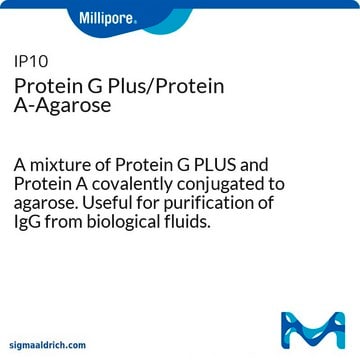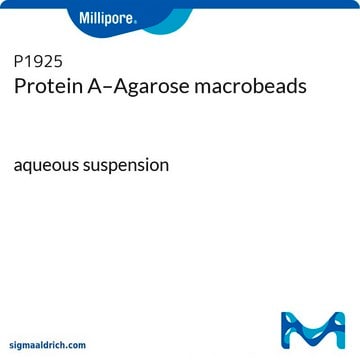PROTAA-RO
Roche
Protein A Agarose
>98% (HPLC and SDS-PAGE), suspension
Synonym(s):
agarose, protein a
About This Item
Recommended Products
assay
>98% (HPLC and SDS-PAGE)
form
suspension
packaging
pkg of 15 mL (05015979001 [settled resin volume])
pkg of 2 mL (11719408001 [settled resin volume])
pkg of 5 mL (11134515001 [settled resin volume])
manufacturer/tradename
Roche
capacity
>18 mg/mL binding capacity (human IgG (polyclonal))(the IgG is loaded at pH 7.4 and eluted with 200 mM glycine, pH 2.0)
storage temp.
2-8°C
General description
Protein A leakage: <18 ng Protein A/ml (ELISA)
Regeneration: the gel can be used approximately 30 times
Structure: recombinant Protein A (E. coli, Mr = 45,000) is covalently coupled to crosslinked 6% agarose beads: 3 mg Protein A (>98% pure, HPLC, SDS-Page)/1 ml gel
Protein A, immobilized.
Specificity
Application
Components
Protein A content: 3 mg/ml pre-swollen gel
Quality
Other Notes
signalword
Warning
hcodes
Hazard Classifications
Eye Irrit. 2 - Flam. Liq. 3
Storage Class
3 - Flammable liquids
wgk_germany
WGK 1
flash_point_f
102.2 °F
flash_point_c
39 °C
Certificates of Analysis (COA)
Search for Certificates of Analysis (COA) by entering the products Lot/Batch Number. Lot and Batch Numbers can be found on a product’s label following the words ‘Lot’ or ‘Batch’.
Already Own This Product?
Find documentation for the products that you have recently purchased in the Document Library.
Customers Also Viewed
Our team of scientists has experience in all areas of research including Life Science, Material Science, Chemical Synthesis, Chromatography, Analytical and many others.
Contact Technical Service










